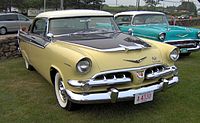Dodge Coronet
| Dodge Coronet | |
|---|---|
 1967 Dodge Coronet R/T | |
| Overview | |
| Manufacturer | Dodge (Chrysler) |
| Production | 1949–1959 1965–1976 |
| Body and chassis | |
| Class | Full-size (1949–1959) Mid-size (1965–1976) |
| Layout | FR layout |
| Chronology | |
| Predecessor | Dodge Custom |
| Successor | Dodge Polara (full-size 1960) |
The Coronet is an automobile that was marketed by Dodge in seven generations, and shared nameplates with the same bodyshell with varying level of equipment installed. Introduced as a full-size car in 1949, it was the division's highest trim line and moved to the lowest level starting in 1955 through 1959. The name was reintroduced on intermediate-sized models from the 1965 to 1976 model years.[1] Muscle car versions were available starting in 1965 with the 440 cu in (7.2 L) Chrysler RB engine, followed in 1966 by the powerful 426 cu in (7.0 L) Chrysler Hemi. Other performance models included the "Superbee", and featured, the 383 cu in (6.3 L) Magnum, among other engine options. The nameplate "coronet" is a type of crown worn by royalty.
In the 1980s, the Coronet was used on Dodge models marketed in Colombia.
First generation (1949–1952)[]
| First generation | |
|---|---|
 1949 Dodge Coronet 4-Door Sedan | |
| Overview | |
| Production | 1949–1952 |
| Assembly |
|
| Body and chassis | |
| Body style |
|
| Related | Chrysler Windsor DeSoto Custom Plymouth De Luxe (Canadian Market only) Dodge Regent |
| Powertrain | |
| Engine | 230 cu in (3.8 L) Dodge Straight 6[2][3] |
| Transmission | 2-speed automatic 3-speed manual "Gyromatic or Fluid drive" |
| Dimensions | |
| Wheelbase | 115 in (2,921 mm) 123.5 in (3,137 mm)[4] |
| Length | |
| Width | 73 in (1,854 mm) (1949–52) 74 in (1,880 mm)[3] |
| Height | 63+1⁄2 in (1,613 mm)[2] |
The Dodge Coronet was introduced with the division's first postwar body styles. Lower trim lines were the Wayfarer and Meadowbrook, with the Wayfarer being built on a shorter 115 inch wheelbase.[6] The only engine for Dodge was a 230-cubic-inch (3,800 cc) flat-head straight six cylinder engine with a single barrel Stromberg carburetor, producing 103 hp (77 kW) (gross). The stock Dodge Coronet was a smooth running car, and the six-cylinder engine could power the car to 90 mph (145 km/h)+ . A limited production model was a four-door, eight-passenger limousine, an extended version of the stock Dodge Coronet which was related to the DeSoto Suburban.[6] One of the most notable features of the first-generation Coronet was a three-speed, fluid-driven transmission that was operated by a foot pedal on the floor. It required no gear selector. It had full instrumentation and 37 inches of head room both front and rear.[7][8]
All Dodge vehicles received a facelift for 1950 but like the 1949 models were still divided into Wayfarer, Meadowbrook, and Coronet lines. The 1950 models can be identified easily by the new grille design which featured 3 heavy horizontal bars. The upper and lower bars formed a stylish oblong shape. Within this oblong grille was a thick center bar with parking lights on each end and a large chrome plaque in the center bearing the Dodge crest. The 8-passenger sedan's length was 216.8 inches.[3]
Dodge received yet another facelift in 1951 but this time the cars remained virtually unchanged for two model years. Busy manufacturing military vehicles for use in Korea, they chose not to dedicate valuable resources to completely redesign civilian vehicles. Still divided into Wayfarer, Meadowbrook, and Coronet lines through 1952, by 1953 the Wayfarer line had been discontinued. The grille of the 1951 model was similar in shape to the 1950 grille, but with the elimination of the thick vertical center bar and the addition of six vents running horizontally between the top and center bars, a whole new look was achieved. The Coronet Diplomat was Dodge's first hardtop coupe, featuring a pillarless steel roof styled after the contemporary Chrysler Newport. The speedometer was now circular, and the other four gauges were rectangles.[3] For 1952 the Coronet had a painted lower grille louver.

1949 Dodge Coronet station wagon
1950 Dodge Coronet

1951 Dodge Coronet Club Coupe

1952 Dodge Coronet Club Coupe
Dodge Wayfarer[]
The Dodge Wayfarer is an automobile produced by Dodge from February 1949 until 1952. It was discontinued without a replacement in the United States, although the Kingsway series remained available in export markets. The Wayfarer was the first true roadster built by the Big Three since the 1930s, offering only accommodation for two passengers and no rear seat.[9] However, the roadster concept was soon altered to the plusher Sportabout as higher comfort levels were demanded by the post-war auto buyers.[10] 9325 roadsters and Sportabouts were built, out of a total of 217,623 Wayfarers of all bodystyles.[11][12]: 263
The "true" 1949 Dodges were introduced in February 1949, after a long production run of the 1948s. The Wayfarer (known as the D-29 series), aside from its shorter wheelbase, shared the boxy corporate design of the new 1949 Chrysler products. While much improved over the earlier Dodges, the Wayfarer still had to do without features such as a crankshaft dampener, the new Micronic oil filter, a splash-proof distributor, and rivetless brake linings. The windshield wipers were vacuum-powered rather than electric, and only the right-hand door received an exterior lock – the roadster receiving none. The Wayfarer arrived with three different bodystyles: a two-door sedan, a two-door business coupe, and the two-door roadster (only entering production in May).[13] The business coupe shared some bodywork with Plymouth's business coupe version, but the other Wayfarers had unique pressings.[5] A one-barrel, L-head inline-six of 230 cu in (3.8 L) was installed, with 103 hp (77 kW). This was to be the only engine option for the Wayfarer's entire production run.
The roadster had removable plastic side windows instead of wind-down units, and a short top which eliminated the need for rear quarter windows. More permanent swing-out vent windows were available as an option. However, Californian regulations on hand signalling meant that roll-down windows had to be added quick and retro-fitted to Californian market vehicles.[13] This happened in September, after which the roll-down windows became a rarely selected delete-option.[10] A roadster with a rumble seat was even tested (with a bottom-hinged trunk lid), but the opening would have had to be moved and the cost of tooling up for such an option meant that it was soon dropped.[13]
1949 production totalled 63,816, equalling 25 percent of Dodge's total number. Of these, 49,054 were sedans, 9342 were coupes, and 5420 were roadsters.[10]
For 1950, the D-33 Wayfarers (as for the entire Dodge lineup) received a facelift with a sleeker grille, new bumpers, and new rear fenders with the taillights mounted directly on them.[14] Mid-year, the roadster was renamed Sportabout as Chrysler realized that very few "true" roadsters were sold. The Sportabout, unlike the rest of the Wayfarer line, also received a body moulding which extended onto the front doors.[10]
A disastrous 104-day strike, lasting from 25 January until 8 May, hamstrung all of Chrysler's production this year.[10] Meanwhile, the arrival of the Rambler Landau convertible meant serious competition for the roadster. While a little more expensive, the new Rambler was much more comprehensively equipped and could seat five rather than two people.[10] Business coupe production also dropped, although the sedan increased for a better overall than in 1949. 75,403 were built, made up of 65,000 sedans, 7500 coupes, and 2903 roadsters/Sportabouts.
1951's D-41 Wayfarers received a thorough upgrade, with a new hood, front fenders, and new slotted grille in two sections. The windshield was bigger and the dashboard new, and underneath there were new "Oriflow" shock absorbers.[11] 1951 was the last year that the Sportabout was available with the removable side windows.[10] A period road tester (Tom McCahill, for Mechanix Illustrated) reached a 87 mph (140 km/h) top speed, and sixty mph from standing was reached in 17.4 seconds.[11]
The 1952s were nearly identical to the 1951s, with Dodge not even bothering to separate the yearly sales numbers.[11] When the 1952s were introduced, the Sportabout was listed with an asterisk regarding availability but was not produced. The business coupe was discontinued in February 1952, with material shortages due to the Korean War forcing automobile manufacturers to focus on their more popular models.[11] Thus, only the two-door sedan was available for most of the Wayfarer's last model year. Production for 1951 and 1952 totalled 78,404, of which 70,700 were sedans, 6702 business coupes, and a mere 1002 of the 1951 Sportabouts.[11] For 1953, the "Meadowbrook Special" series was added to replace the Wayfarer at the lower end of Dodge's lineup.[12]

1949 Dodge Wayfarer roadster

1950 Dodge Wayfarer Sportabout roadster

A 1950 Dodge Wayfarer two-door sedan

1952 Dodge Wayfarer business coupe
Dodge Meadowbrook[]
The Dodge Meadowbrook is a full-size car that was produced by Dodge in the United States from 1949 to 1954. It was produced by Dodge and offered as the midline trim level from February 1949 until 1954, above the Wayfarer and beneath the Coronet. The Meadowbrook was largely identical to the Coronet, excepting trim and equipment differences.[12]: 266 In 1952 the Wayfarer was cancelled and the Meadowbrook became the lowest-priced Dodge in the United States; export markets (including Canada) continued to receive the Plymouth-based Dodge Kingsway. In its first year the four-door only Meadowbrook made up 30% of Dodge's sales (about 90,000 units), and came with "Safe-Guard Hydraulic Brakes" which included two cylinders per front brake. Dodge also advertised a new "cradled" ride, which was supposedly softer than all the others makers cars. The single-barrel inline-six produced 103 hp (77 kW).[15]
For 1950, the six-cylinder was baptized the "Get-Away" engine. After the late introduction of the 1949s, the 1950 Dodges appeared a little earlier, on 4 January 1950.[16] The 1950 Meadowbrook has a wide, 42.7 ft (13.0 m) turning circle.[17][18] Four-door sedan bodywork remained the only option.[16]
The 1951 Meadowbrook received a thorough change, with all-new front skin. Bumpers were also new, as was the dashboard, and the windshield was enlarged.[19] The engine remained unchanged, as it would until 1954. In 1952, the Meadowbrook made up 32.50% of Dodge's sales (circa 84,000). With Chrysler being entirely focussed on the Korean War effort, the 1952s received almost no changes – modifications being limited to details such as a red reflector dot beneath the taillights and lightly redesigned hubcaps.[19] The 1952s were introduced on 10 November 1951.[20]
Chrysler Wayfarer[]

The Wayfarer model name was also used by Chrysler Australia for the Chrysler Wayfarer, a series of ute models built between late 1958 and 1960 (AP2 and AP3 models, some perhaps built as late as 1961) in 1205 examples.[21] Later, there was a ute called the "Chrysler Valiant Wayfarer". This model was built from April 1965[22] until August 1971.
Second generation (1953–1954)[]
| Second generation | |
|---|---|
 1953 Dodge Coronet Club Coupe (with non-standard wheels) | |
| Overview | |
| Model years | 1953–1954 |
| Assembly |
|
| Body and chassis | |
| Body style | 4-door sedan 2-door coupe 2-door station wagon |
| Related | DeSoto Fireflite Plymouth Belvedere (Canadian market only) Dodge Mayfair |
| Powertrain | |
| Engine | 241 cu in (3.9 L) Red Ram V8 230 cu in (3.8 L) Dodge Straight 6 |
| Transmission | 2-speed automatic 3-speed manual Gyrol fluid Drive Gyro-Torque Drive[3] |
| Dimensions | |
| Wheelbase | 119 in (3,023 mm)[3] |
| Length | 201.4 in (5,116 mm)[3][23] |
For 1953, the Coronet was totally redesigned.[3] It gained an optional 241 cu in (3.9 L) "Red Ram"[24] Hemi Engine and set over 100 land speed records at the Bonneville Salt Flats.[25] The windshield finally became one-piece.[3] Electric windshield wipers were standard, while the radio cost $83.[3]
The Dodge Royal line was added above the Coronet in 1954. Dodge was putting more luxury into all of its models which included the Meadowbrook, Coronet and new Royal lines. Still, styling changes for 1954 were modest. The chrome molding on the hood lip was wider than on the 1953 models and a large chrome upright in the center of the grille replaced the five vertical dividers used previously. It still came with full instrumentation.[26] 1954 saw Chrysler's first fully automatic transmission, two-speed PowerFlite, offered as an extra-cost option on all Dodges.
Dodge Meadowbrook[]
The 1953 Dodges arrived on 23 October 1952, and featured a revised bodywork based on the 1952s. The doors (now with pull-handles) opened wider, the rear window was a one-piece, and the taillights were oval units. Naturally the grille and chrome applications were altered.[20] The "Meadowbrook Special" series was added to replace the Wayfarer at the lower end of Dodge's lineup.[27] A two-door model and a station wagon were also added.[28] The two- and four-door sedans were both offered in both Meadowbrook and Special trim levels, but the Special did not suit the buoyant US car market and by April 1953 it had already been discontinued. Instead, sales of the new V8-engined Coronet were very strong. The austere Special, intended for travelling salesmen and the like, received no chrome side trim and plain rubber trim around the windows. The interior was equally bare.[20]
The two-door Suburban wagon, offered for 1953 only, sat on a shorter 114 in (2,900 mm) wheelbase than the sedans.[20]
1954 was the last year of the Meadowbrook,[15] and it had a new Powerflite automatic.[29] Offered as a four-door or two-door sedan (called Club Coupé), it was now also available with the optional new "Red Ram" Hemi V8 engine.[20] Of 241.3 cu in (4.0 L), it produces 140 hp (104 kW) for the Meadowbrook, ten horsepower less than in the more senior Dodges due to a lower compression ratio. Thanks to a modest compression increase, the "230" six increased its power output to 110 hp (82 kW).[30] Buyers still flocked to the more prestigious Coronet and Royal lines, and only 15,444 were built.[20]
Dodge Royal[]
The Royal was introduced for the 1954 model year as the top trim level of the Dodge line, above the mid level Dodge Coronet and the base level Dodge Meadowbrook.[31] It was offered only with a 241 cubic inch 'Hemi' V8 engine.[31] The 1954 Royal V-8 range comprised 4-Door Sedan, Convertible, Club Coupe and Sport Coupe,[32] the latter being a 2-door hardtop.

1953 Dodge Coronet Sierra 2-door wagon
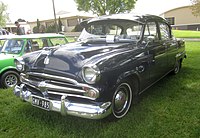
1954 Dodge Meadowbrook, four-door sedan

1954 Dodge Royal V-8 4-Door Sedan
Third generation (1955–1956)[]
| 1955 Dodge | |
|---|---|
 1955 Dodge Custom Royal Lancer sedan | |
| Overview | |
| Manufacturer | Dodge (Chrysler) |
| Also called | Dodge Coronet Dodge Suburban Dodge Royal Dodge Sierra Dodge Royal Lancer Dodge Custom Royal Dodge Custom Royal Lancer |
| Production | 1955��1956 |
| Assembly |
|
| Body and chassis | |
| Class | Full-size |
| Body style | 2-door coupe 4-door sedan 2-door hardtop coupe 2-door wagon 4-door wagon 2-door convertible |
| Layout | FR layout |
| Related | DeSoto Custom Plymouth Belvedere Dual-Ghia D-500 |
| Powertrain | |
| Engine | 230 cu in (3.8 L) Getaway I6 270 cu in (4.4 L) Red Ram V8 315 cu in (5.2 L) "Poly" V8 325 cu in (5.3 L) Chrysler Hemi V8 350 cu in (5.7 L) Chrysler "B" V8 361 cu in (5.9 L)Chrysler "B" V8 |
| Transmission | 2-speed automatic 3-speed manual 3-speed automatic |
| Dimensions | |
| Wheelbase | 120 in (3048 mm) |
| Length | 212.1 in (5387 mm) |
The 1955 Coronet dropped to the lower end of the Dodge vehicle lineup, with the Wayfarer and Meadowbrook names no longer used and the Custom Royal added above the Royal, Lancer, and La Femme. Bodies were restyled with help from newly hired Virgil Exner to be lower, wider, and longer than the lumpy prewar style, which in turn generated a healthy boost in sales over 1954. Power came from either a 230 cu in (3.8 L) Chrysler Flathead engine straight-6, now producing 123 hp (92 kW) Two V8 engines were offered: 270 cu in (4.4 L) Polyspheric (poly or semi-hemi) heads producing 175 hp (130 kW) and a 315 cu in (5.2 L) (the "Hemi"). Driven almost out of business in 1953 and 1954, the Chrysler Corporation was revived with a $250 million loan from Prudential and new models designed by Virgil Exner. The Dodge lineup was positioned as the mainstream line in Chrysler's hierarchy, between DeSoto and Plymouth.
The Coronet (and Suburban station wagon) was the base model. This was the only line to feature the 230 in3 (3.8 L) Getaway I6 as well as the 270 in3 (4.4 L) Red Ram V8. Coronets were available in all body styles except the convertible. Sedans feature "Coronet" badges on the fenders, while the station wagons are called "Suburban". Although the hardtop coupe was officially named "Lancer", it wore only "Coronet" badges. Turn signals were standard on the Royal and Custom Royal models but optional on the base Coronet.
Power windows were new.[33] Wheelbase was 120 inches. They were 212.1 inches long.[34] The trim lines available:
- 2- or 4-door station wagon — The Coronet wagon used the Suburban name and had the V8 or six
- hardtop coupé — The V8 Coronet Lancer
- 2- or 4-door sedan — V8 or Six
- 2-door sedan — V8 or Six
- 4-door, eight-passenger limousine
Dodge D-500[]
The D-500 was the first Dodge factory high performance made in honor of the (D-500-1) "Super Stock" model with the only external clues being discreet crossed checkered flags and "500" lettering on its hood and lower rear deck it was also available for order from the dealer on Coronet models, including station wagons and two-door sedans and was related to the 1955 Chrysler C-300. The standard D-500 trim included a 315 cu in (5.2 L) V8 with hemispherical heads (unlike other Dodge V8s (List of Chrysler engines) which used Polyspheric heads), a unique camshaft, valve lifters, pushrods, carburetor, ignition, and pistons. With a compression ratio of 9.25:1, four-barrel Carter WCFB carburetor, and dual-point distribution, peak horsepower was 260 bhp (190 kW) while torque was a solid 330 lb⋅ft (450 N⋅m). The D-500 also received an upgraded suspension with stiff front coil springs; heavy-duty Oriflow shock absorbers, with the same valving specified for Dodge police cars, were mounted in the springs. Similar units were used in the rear. Overall height of the D-500 was 1.5 inches (38 mm) lower than its standard Dodge counterpart. The D-500 came standard with 15x5.5 inch wheels with 7.60x15 inch tubeless tires. New for safety were safety door locks.[35] The D-500-1 (the first 500 made required by NASCAR, was intended for NASCAR competition. The D-500-1 had an even stiffer suspension than the D-500. Under the hood, the engine received larger valves (about 18% larger), a full-race camshaft, and a double log intake manifold that used two four-barrel Carter WCFB carburetors and a shaved deck for 8.25:1 compression. This all added up to 285 bhp (213 kW). It was the fastest car that year from the factory.
Dodge Royal[]
The introduction of the Dodge Custom Royal for the 1955 model year saw the Royal moved down to the intermediate trim level, above the now base-model Coronet.[31] The Royal Lancer name was applied to the 2-door hardtop model and Royal Sierra to the new station wagon models.[31] The Royal (and Sierra wagon) were the next step up. Featuring only the V8 engine, the Royal also lacked the 2-door sedan and wagon models available in the Coronet line. Early hardtop coupes lack the "Lancer" script, although they were officially Lancers, but later models wore "Royal Lancer" badges.
For 1956 the use of the Royal Lancer name was extended to include a new 4-door hardtop model.[31] Station wagons now included 2-door Royal Custom Suburban and 4-door Royal Custom Sierra models.[31] External changes were mainly the growth of tailfins, redesigned taillight housings and side trim treatments. Changes at the front were limited to the addition of six "fins" in the grille (not to be found on the lower-grade Coronet) and an altered hood ornament.[36]
Dodge Custom Royal[]
The Dodge Custom Royal is an automobile which was produced by Dodge in the United States for the 1955 through 1959 model years.[31] In each of these years the Custom Royal was the top trim level of the Dodge line, above the mid level Dodge Royal and the base level Dodge Coronet.[31] 2 Door and 4 Door Hardtop models, along with the convertible were referred to as "Custom Royal Lancers" only the 4 Door Sedan was known as strictly a "Custom Royal". The Custom Royal was assembled by Chrysler Australia at its Mile End plant in South Australia from early 1958 utilizing CKD kits imported from Detroit.[37] It was offered only as a four-door sedan.[37] The flagship model was the Custom Royal. All hardtop coupe and Custom Royal-only convertible models were called Custom Royal Lancer. The Custom line featured unique chrome tailfins (although early model year cars went without this trim), special tail light surrounds, and an upscale interior. Backup lights were standard on the Custom line but optional on all others. The Custom Royal also featured the hemi 270 CID Super Red Ram engine.[38]
A La Femme option was available on 1955 and 1956 Dodge Custom Royal Lancer models.[31]

1955 Custom Royal Lancer hardtop coupe

1955 Dodge Royal Lancer hardtop coupe

The 1956 Dodge Royal only saw detail changes
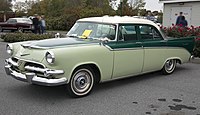
1956 Dodge Coronet 4-door sedan

1956 Dodge Coronet coupe

1955 Dodge Custom Royal 4-Door Sedan
1956 Dodge Custom Royal Lancer 2-Door hardtop
Dodge Custom Royal La Femme[]

The Dodge Custom Royal La Femme is a full-sized automobile that was produced by Dodge between 1955 and 1956. The automobile was specifically designed for women.[39] The La Femme option was available on 1955 and 1956 Dodge Custom Royal Lancer models.[31]
The La Femme stemmed from the observation of Chrysler's marketing department that more women were taking an interest in automobiles during the 1950s, and that women’s opinions on which color car to buy was becoming part of the decision-making process for couples buying an automobile. The La Femme was an attempt to gain a foothold in the women's automobile market.
The La Femme concept was based upon two Chrysler show cars from the 1954 season. Named Le Comte, and La Comtesse, each was built from a Chrysler Newport hardtop body and was given a clear plastic roof over the entire passenger compartment. While the Le Comte was designed using masculine colors, the La Comtesse was painted "Dusty Rose" and "Pigeon Grey" in order to convey femininity. Favorable responses encouraged Chrysler to pursue the La Comtesse concept.
Dodge received the project and renamed the concept the La Femme, which began as a 1955 Dodge Custom Royal Lancer "spring special" hardtop two-door coupe, painted "Sapphire White" and "Heather Rose". From there, the exterior received special gold-colored "La Femme" scripts that replaced the standard "Custom Royal Lancer" scripts on the cars front fenders.
The interior of the car also received attention and features. 1955 La Femme interiors were upholstered in a special tapestry material featuring pink rosebuds on a pale silver-pink background and pale pink vinyl trim. The La Femme came with a keystone-shaped, pink calfskin purse that coordinated with the interior of the car. The purse could be stowed in a compartment in the back of the passenger seat,[40] and its gold-plated medallion faced outward. This brushed-metal medallion was large enough to have the owner's name engraved on it.
Each purse was outfitted with a coordinated set of accessories inside, which included a face-powder compact, lipstick case, cigarette case, comb, cigarette lighter, and change purse, all made of either faux-tortoiseshell plastic and gold-tone metal, or pink calfskin and gold-tone metal, and all were designed and made by “Evans”, a maker of women's fine garments and accessories in Chicago.
On the back of the driver's seat was a compartment that contained a raincoat, rain bonnet, and umbrella,[41] all made from a vinyl patterned to match the rosebud interior fabric. Marketing brochures stated that the car was made "By Special Appointment to Her Majesty... the American Woman."
In 1956, the La Femme returned, with letters from Dodge’s marketing department to dealerships calling the La Femme a "stunning success". For 1956, Dodge replaced the Heather Rose and Sapphire White scheme with a Misty Orchid and Regal Orchid color scheme. The interior of the car in 1956 did not take its cue from the 1955 model, and instead featured "La Femme"-only seat patterns, headliner, interior paint, and carpet. The fabrics used have proven difficult to reproduce. The seat coverings were made of a heavy white cloth with random, organic-seeming patterns of short lavender and purple loops, in a manner similar to loop-pile carpeting. The headliner cloth was heavy white fabric, with many tiny random splashes of gold paint. The carpeting was loop pile with several shades of lavender and purple. The boxes behind the seats were changed for 1956 to accommodate the rain coat, rain cap and umbrella provided with the model. Both boxes were identical this year, because there was no need to accommodate a purse, which was only offered with the 1955 La Femme.
Dodge dropped the La Femme for 1957 and did not revisit the concept. Because the La Femme was an option package ($143), its total production was never broken out from Dodge's production numbers, although research suggests fewer than 2,500 were made over the two-year period. At least 40 known examples exist of the 1955 version and over 20 for the 1956 version, including at least 3 verifiable Dodge D-500 engine optioned 1956 La Femme.[citation needed]
Many theories exist concerning the low sales of the La Femme trim package. Given the large number of Dodge dealerships in the U.S. at the time, few of them received a demonstration La Femme for their showroom. Entitled “By Special Appointment to Her Majesty... the American Woman" dealer three-fold single-sheet pamphlets promoted the car as "in mood and manner" for a "discriminating, modern woman."[42][43] Other trim-special models such as the Chrysler 300 letter series, Plymouth Fury, and DeSoto Adventurer were widely promoted.

1956 Dodge La Femme
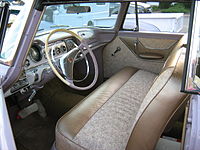
1956 La Femme interior

Gold-colored "La Femme" fender script
Fourth generation (1957–1959)[]
| Fourth generation | |
|---|---|
 1958 Dodge Coronet 4-Door Sedan | |
| Overview | |
| Also called | Dodge D-501 |
| Production | 1957–1959 |
| Assembly | Newark Assembly, Newark, Delaware Dodge Main Factory, Hamtramck, Michigan |
| Body and chassis | |
| Body style | 2-door coupe 4-door sedan 4-door station wagon 2-door convertible |
| Related | Chrysler Saratoga Chrysler Windsor DeSoto Firedome Plymouth Belvedere (engine and transmission only) Facel Vega FVS Facel Vega Excellence |
| Powertrain | |
| Engine | 354 cu in (5.8 L) Chrysler FirePower V8 325 cu in (5.3 L) "Red Ram" 230 cu in (3.8 L) "Getaway" L-head straight-6 |
| Dimensions | |
| Wheelbase | 122 in (3,099 mm) 126 in (3,200 mm) [44] |
| Length | 218 in (5,537 mm) (1957)[15] 222.1 in (5,641 mm)(1959) |
| Width | 78.2 in (1,986 mm) (1957)[15] |
| Chronology | |
| Successor | Dodge Custom 880 (full-size 1962) |

The 1957 model year debuted a new D-501, which replaced the D-500 from the year before as the top Coronet. The D-501 received Chrysler's proven 354 cu in (5.8 L) Hemi V8, which were actually leftover engines from the 1956 Chrysler 300B production. Camshafts from the 1957 Chrysler 392 cu in (6.4 L) engines were installed in the 354 cu in (5.8 L) V8s. A pair of Carter four-barrel carburetors fed the 10.0:1 compression ratio to produce 340 bhp (250 kW), shared with the DeSoto Adventurer and the Chrysler 300C. Other changes included the addition of the Torsion-Aire Ride (torsion bar) front suspension[3] and a heavy-duty suspension with heavy-duty shock absorbers and a heavy-duty leaf-sprung rear. A 3.73:1 rear axle was standard with the three-speed manual transmission and automatic cars included a 3.18:1 rear axle. There were 13 optional rear axles available, ranging from 2.92:1 through 6.17:1. The D-501 received 7.60x15 tires on 15x8-inch wheels. Brakes were 12-inch (300 mm) diameter drums. Only 101 D-501s were produced. A padded dash was optional.[45]
In the September 1957 issue of Popular Mechanics, owners of both the Coronet six-cylinder and eight-cylinder were surveyed.[46] Many people (37.6% of I6 owners and 34.8% of V8 owners) complained that there were too many water leaks. When PM tested a V8 Coronet for water resistance, water got into the engine and pooled in "two spark plug wells" which had to be siphoned out before the engine could run with all cylinders again.[46] However, many did like the exterior styling and the ride comfort. 0-60 mph on 90 octane gasoline was 12.3 seconds.
The 1958 and 1959 Coronet, Royal, and Custom Royal used a DeSoto Fireflite chassis but had less ornate trim. Power came from the 230 cu in (3.8 L) "Getaway" L-head straight-6 or the 325 cu in (5.3 L) "Red Ram" V8. In 1959 a Silver Challenger model was also offered on the Coronet line. This was a six-cylinder or V-8 model available only in silver paint and only on a two-door body. It came with many extra features at no cost, such as wall-to-wall deep pile carpeting, premium white wall tires and wheel covers, luxury fabrics and upgraded interior and electric windshield wipers.[47] The overall length was increased to 217.4 inches.[3]
The Dodge Custom Royal was also assembled by Chrysler Australia from early 1958 to 1960.[48]
A Dodge Coronet was the only known example of the JATO Rocket Car legend. To publicize Dodge's 'total contact' front dual-leading shoe drum brakes a JATO unit was fitted to a 1958 Coronet and driven at speed across the El Mirage dry lake. A TV advertisement was broadcast during Dodge-sponsored Lawrence Welk Show.[49]
1959 Dodge Silver Challenger[]
The first car that carried the Challenger name was introduced as the limited edition Dodge Silver Challenger Club Sedan, an addition to the 1959 full-sized Dodge Coronet model line.[50] and was related to the Dodge Matador.
The Silver Challenger came only in silver paint and exclusively on Chrysler's 217.4 in (5,520 mm) long two-door, on a 122 in (3,100 mm) wheelbase. It was available with either the 230 cu in (3.8 L) "Getaway" L-head straight-six engine for $2,297 ($20,392 in 2020 dollars [51]), or the 326 cu in (5.3 L) "Red Ram" V8 for $2,408 ($21,378 in 2020 dollars [51]).[52] This car was marketed for the spring selling season to "new-car buyers who've been waiting to get the most for the least."[53] A column-shifted three-speed manual transmission was standard and an automatic was optional.
The 1959 Silver Challenger was marketed with extra features at no extra cost. These included premium white wall tires, full wheel covers, electric windshield wipers, as well as an upgraded interior with silver metallic vinyl and black "Manchu" fabric upholstery, dual arm rests and sun visors, as well as deep pile wall-to-wall carpeting.[53][54]

1959 Dodge Silver Challenger
Dodge Royal[]
The Royal continued as the intermediate trim level in the Dodge line for models years 1957 through 1959.[31] A Royal Lancer Convertible was added for 1957 only and the station wagons were moved to their own series in the same year.[31]

1957 Dodge Royal

1958 Dodge Royal 4-Door Sedan
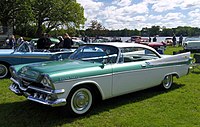
1957 Dodge Custom Royal Lancer 2-Door hardtop

1958 Dodge Custom Royal 4-Door Sedan

1959 Dodge Custom Royal Lancer 2-Door hardtop
Fifth generation (1965–1970)[]
1965–1967[]
| Fifth generation | |
|---|---|
 1966 Dodge Coronet 500 SE | |
| Overview | |
| Production | 1965–1970 |
| Assembly | Lynch Road Assembly, Detroit, Michigan Saint Louis Assembly, Fenton, Missouri Los Angeles Assembly, Maywood, California Bogotá, Colombia |
| Body and chassis | |
| Body style | 4-door wagon (1965–70) 4-door sedan (1965–70) 2-door sedan (1965–67) 2-door coupe (1968–70) 2-door hardtop (1965–70) 2-door convertible (1965–70) |
| Platform | B-body |
| Related | Plymouth Belvedere Plymouth Savoy Dodge Charger Plymouth GTX Plymouth Road Runner |
| Powertrain | |
| Engine | 225 cu in (3.7 L) Slant-6 I6 273 cu in (4.5 L) LA V8 318 cu in (5.2 L) A V8 318 cu in (5.2 L) LA V8 361 cu in (5.9 L) B V8 383 cu in (6.3 L) B "Magnum" V8 426 cu in (7.0 L) Hemi V8 440 cu in (7.2 L) RB "Magnum" V8 |
| Transmission | 3-speed manual 4-speed manual 3-speed automatic |
| Dimensions | |
| Wheelbase | 116.0 in (2,946 mm) Wagon: 117.0 in (2,972 mm) |
| Length | 209.7 in (5,326 mm) |
The Coronet reappeared for the 1965 model year as the intermediate sized B-body using a 117-inch wheelbase, continuing what had been the Dodge Polara, which was once again full-size. For 1965, Dodge sold slightly over 209,000 units, making the Coronet the most popular model sold by Dodge that year. Trim levels initially were base Coronet including a Deluxe version, Coronet 440, and Coronet 500.
The base Coronet and Deluxe were available as two-door sedans, four-door sedans, and station wagons. For 1965 only, Dodge also sold 101 units of a modified wheelbase version of the base Coronet two-door sedans and 440 hardtops specifically for NHRA drag racing. The model known as A990 came with a racing version of the 426 cu in (7.0 L) Hemi engine. The car A990 was stripped of all features and included lightweight base bucket seats from Dodge's A100 truck/van line of vehicles. These altered wheelbase vehicles eventually became popularly known as "funny cars" due to their unique wheel spacing.
The front and rear axles were moved forward significantly from the stock location, putting the front wheels directly behind the front fender, and the rear wheels almost under where the rear seat would normally go; this alteration transferred weight to the rear tires, increasing traction on launch. These were described as funny cars and a new genre of drag racers. Front seat belts and padded dash were standard.[55]
The middle of the Coronet line-up was the 440 and was available as a two-door hardtop, convertible, or station wagon. The 440 designation did not indicate engine displacement as commonly assumed (both then and now, which helped sales to an extent). The nomenclature was a carryover theme from the 1963–64 Polara series. The top of the Coronet line-up was the Coronet 500 and was available as a two-door hardtop or convertible in 1965. Slightly over 33,300 units were sold in 1965 and included as standard, a V8 engine (273 cubic inches), exterior trim and badging, bucket seats, padded dash, and chrome floor console.
Coronets were manufactured at Chrysler's Los Angeles assembly plant and at Lynch Road assembly plant in Detroit and ST. Louis plant in Missouri. Engines offered for 1965 included the base 225 Slant-Six, 273, 318 (Polyhead), 361 (the last year for this big block engine was 1966), 383, and 426 in multiple HP choices ( the 383 came in a special version rated at 330 HP). Sales brochures list the 413 (its last year offered) as available, but no records exist of this engine, commonly used in Imperials, being installed in Coronets for 1965.[56] A tachometer was optional.[57]
In 1966 a four-door Coronet 500 was added, called the Coronet 500 SE (Special Edition). It had special "SE" logos on the C-pillars and on the seatback.[58] There would be no Coronet 500 wagon until 1968. Coronet received a redesign in 1966, and a facelift in 1967. Trim levels initially were base Coronet, Coronet 440, and Coronet 500. In 1966, the Coronet Deluxe was introduced, fitting between the base Coronet and the Coronet 440. The Coronet R/T was introduced in 1967.
The Coronet R/T was available as a two-door hardtop or convertible. The standard engine was Chrysler's largest, the 440 cu in (7.2 L) V8 producing 375 bhp and dubbed the Magnum. The only engine option was the 426-cid Hemi, now in its second year in "Street" trim and again rated at 425 bhp. It was a $908 option. Transmission choices were Mopar's excellent heavy-duty three-speed TorqueFlite automatic or a four-speed manual.
When the 426ci Hemi was made available to the general public for the 1966 model year, it could be ordered in any Coronet model or trim level. No Hemi-powered Coronet wagons have been verified, but a few Coronet Deluxe four-door sedans are known to exist. A total of 136 Coronet 500 Street Hemis were built for 1966.[59] Beginning in 1967, Chrysler decided that the Hemi should be available only in their badged muscle cars: the Dodge Charger and Coronet R/T and the Plymouth Belvedere GTX. The top engine option for the rest of the Coronet line was supposed to be the 383-ci, 4-barrel V8. Despite this, some Hemi-powered 1967 Coronet Deluxe two-door sedans were produced. There is also one Hemi-powered 1967 Coronet 440 two-door hardtop known[citation needed], and One Hemi-powered 1967 Coronet 500 two-door hardtop known, which is not among the 55 WO23 Super Stock cars produced for Dodge drag racers.
1968–1970[]
The Coronet and similar Plymouth Belvedere received complete redesigns in 1968, as did the Dodge Charger, which shared the B-body platform. There was a mild facelift in 1970. Trim levels initially included the base Coronet, Coronet Deluxe, Coronet 440, Coronet 500, and Coronet R/T. The Coronet Super Bee was introduced in early 1968 as a companion to the Plymouth Road Runner. In keeping with Dodge's position as a step above Plymouth, the Super Bee shared the Charger's Rallye instrument cluster and the Coronet 440's rear finish panel.
As in 1967, the 440ci RB V8 was only available in the Coronet R/T in 1968. The 426ci Hemi V8 was supposed to be limited to the R/T and Super Bee, but two 1968 Coronet 440s are known to have been built with this engine.
In mid-1969, the A12 package was introduced on the Super Bee. It included a 390 hp (291 kW) version of the 440 with three 2bbl Holley carburetors on an aluminum intake manifold, a black fiberglass lift-off hood secured with metal pins, heavy-duty suspension, and 15-inch steel wheels with no hubcaps or wheel covers. The hood had an integrated forward-facing scoop which sealed to the air cleaner assembly and bore a decal on each side with the words "SIX PACK" in red letters, "Six Pack" being the name used for the 6-bbl induction setup when installed on a Dodge (Plymouth went with "440 6bbl" on the A12 Road Runners). The A12 Super Bee could be had with most Super Bee options, with the exception of air conditioning and tire-wheel packages. The A12 option was a 1969-only package, but the 440 6bbl returned in 1970 as an optional engine on both the Super Bee and the Coronet R/T.
The base Coronet and Deluxe were available as 2-door coupes, 4-door sedans, or station wagons. The base Coronet was dropped in 1969, leaving the Deluxe as the lowest trim level through 1970. The Coronet 440 convertible was dropped for 1968, but a 2-door coupe was added along with the 2-door hardtop, 4-door sedan, and station wagon. This would remain the lineup through 1970. Coronet 500 retained its 2-door hardtop, convertible, and 4-door sedan through 1970. A Coronet 500 station wagon made its debut in 1968, continuing through 1970. Simulated woodgrain trim was standard on the Coronet 500 wagon.
The Coronet R/T 2-door hardtop and convertible continued through 1970.
The Super Bee was available as a 2-door coupe or 2-door hardtop. Chrysler did display a convertible with Super Bee stripes at car shows in 1968, but never offered it as a production model. Some enthusiasts have created "phantom" Super Bee convertibles by adding the appropriate trim and stripes to Coronet 500 convertibles.
The Dodge Super Bee was a limited-production muscle car from 1968–1971. The original Super Bee was based on the Dodge Coronet, a 2-door model and was produced from 1968–1970. It was Dodge’s low-priced muscle car, the equivalent to Plymouth Road Runner, and was priced at $3,027. Available with the Hemi engine, this option increased the price by 33% thus 125 models were sold with this engine option. The Super Bee included a heavy-duty suspension, an optional Mopar A-833 four-speed manual transmission, with high-performance tires, and a stripe (with the bee logo) wrapped around the tail. The name "Super Bee" was derived from the "B" Body designation given Chrysler's mid-size cars which included the Coronet.
A “six-pack” (three two-barrel carburetors) version of the 440 engine was added to the list mid-year. This engine was between the standard engine and the Hemi as a $463 option. The 1969 model year included the base 383 hp (high performance) with the 440 six-pack and 426 Hemi optional. The 440 Magnum (4-bbl) was not offered, but available in the Coronet R/T.
In 1970, the Super Bee was given a different front end look that consisted of a dual oval-shaped grill that was referred to as “bumble bee wings”. Engines, as well as the "ramcharger" hood (that carried over from the 1969 model). Sales fell for the 1970 model. In 1970, four Super Bee convertibles were built.

1965 Dodge Coronet 440 4-Door Station Wagon

1966 Dodge Coronet 440 2-door hardtop

1968 Dodge Coronet 500
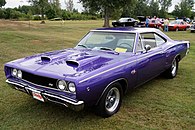
1968 Dodge Coronet R/T

1969 Dodge Coronet Super Bee

1970 Dodge Coronet Super Bee
Sixth generation (1971–1974)[]
| Sixth generation | |
|---|---|
 1974 Dodge Coronet Custom 4-Door Sedan | |
| Overview | |
| Production | 1971–1974 |
| Assembly | Hamtramck, Michigan, United States |
| Body and chassis | |
| Body style | 4-door wagon 4-door sedan |
| Platform | B-body |
| Related | Plymouth Belvedere Plymouth Savoy Plymouth Satellite Dodge Charger Plymouth GTX Plymouth Road Runner |
| Powertrain | |
| Engine | 225 cu in (3.7 L) Slant-6 I6 318 cu in (5.2 L) 318 LA V8 383 cu in (6.3 L) B "Magnum" V8 400 cu in (6.6 L) B V8 440 cu in (7.2 L) RB "Magnum" V8 |
| Transmission | 3-speed Chrysler A320 manual 3-speed TorqueFlite A727 automatic 4-speed Chrysler A833 manual |
| Dimensions | |
| Wheelbase | 118.0 in (2,997 mm)[60] |
| Length | Sedan: 207.0 in (5,258 mm) Wagon: 213.4 in (5,420 mm)[60] |
| Width | Sedan: 77.7 in (1,974 mm) Wagon: 56.4 in (1,433 mm) |
| Height | Sedan: 53.7 in (1,364 mm) Wagon: 63.4 in (1,610 mm) |
The new Coronet was a twin of the four-door Plymouth Satellite and featured more flowing styling. It was offered as a sedan and wagon, the related and also restyled Dodge Charger covering the coupe market. Slight alterations of the front grille, headlights, and taillights followed in 1972. Sales of the Coronet were low from this point onwards, with around 80–90,000 produced each year through 1973 (compared with 196,242 as recently as 1968), due both to the fuel crisis and to a proliferation of Dodge and Plymouth models, and the growing effect of overlap with the other Chrysler Corporation brands.[61] In addition to the usual changes to the grille, lights, and interior, Dodge introduced its "TorsionQuiet" system of additional silencers and rubber vibration insulators, providing a much smoother ride and a quieter interior.
The front and rear fascias were redesigned, most notably the rear bumper, which met the 1974 DOT requirements. The sedan body style would be the basis of the later Coronets (and its twin, the Plymouth Fury) until the 1978 model year.
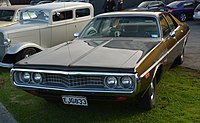
1972 Dodge Coronet Custom sedan
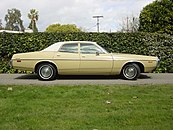
1973 Dodge Coronet Custom sedan
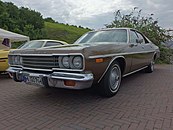
1974 Dodge Coronet Custom 4-Door Sedan
Seventh generation (1975–1976)[]
| Seventh generation | |
|---|---|
 1975 Dodge Cornet Custom 4-Door Sedan (with non-standard wheels) | |
| Overview | |
| Production | 1975–1976 |
| Assembly | Hamtramck, Michigan, United States |
| Body and chassis | |
| Body style | 4-door wagon (1975–76) 4-door sedan (1975–76) 2-door hardtop/coupe (1975 only) |
| Platform | B-body |
| Related | Plymouth Fury |
| Powertrain | |
| Engine | 225 cu in (3.7 L) Slant-6 I6 318 cu in (5.2 L) LA V8 360 cu in (5.9 L) LA V8 400 cu in (6.6 L) B V8 440 cu in (7.2 L) RB V8 (police) |
| Transmission | 3-speed Chrysler A320 manual 3-speed TorqueFlite A727 automatic 4-speed Chrysler A833 manual |
| Dimensions | |
| Wheelbase | Sedan & Wagon: 118.0 in (2,997 mm)[62] Coupe: 115.0 in (2,921 mm) |
| Length | Sedan: 217.9 in (5,535 mm) Coupe: 213.8 in (5,431 mm) Wagon: 225.6 in (5,730 mm) |
| Width | Sedan: 77.7 in (1,974 mm) Coupe: 77.4 in (1,966 mm) Wagon: 79.2 in (2,012 mm) |
| Height | Sedan: 53.9 in (1,369 mm) Coupe: 52.6 in (1,336 mm) Wagon: 56.5 in (1,435 mm) |
1975[]

For 1975 the Coronet received a refreshed squarer-appearing body as well as a new front fascia with two round dual-beam headlights shared with its Plymouth Fury stablemate. After a four model year absence, a Dodge Coronet 2-door returned for 1975.
1976[]
1976 was the final model year for the Dodge Coronet and its body style choices reduced to the four-door wagon and the four-door sedan. The former Dodge Coronet 2-door model was replaced by the Dodge Charger Sport for the 1976 model year.
For the 1977 model year, the mid-size Dodge Coronet was renamed Monaco, and the full-size Dodge Monaco was renamed Royal Monaco.
Coronet in Colombia[]
Coronet was used as the model name for the Colombian market Dodge Diplomat during the 1980s.
References[]
- ^ Zatz, David. "The Dodge Coronet: father of the Super Bee". Allpar. Retrieved February 3, 2021.
- ^ Jump up to: a b c It's true...it's New...it's Dodge for fifty-two (brochure), Chrysler Corporation: Dodge Division, 1951, retrieved 2015-07-03 – via Oldcarbrochures.com
- ^ Jump up to: a b c d e f g h i j k l m n Flory, Jr., J. "Kelly" (2008). American Cars, 1946–1959 Every Model Every Year. McFarland. ISBN 978-0-7864-3229-5.
- ^ Ristic-Petrovic, Dusan. "1949 Dodge foldout". Old Car Brochures.com. Retrieved November 20, 2011.
- ^ Jump up to: a b Godshall, p. 77
- ^ Jump up to: a b Godshall, Jeffrey I. (1980). "Wayward Wayfarer: The story of a Dodge". Automobile Quarterly. XVIII (1): 77. ISSN 0005-1438.
- ^ "1949 Dodge D29 D30 manual". Old Car Brochures.com. p. 4. Retrieved January 3, 2016.
- ^ "1949 Dodge brochure". Old Car Brochures.com. Retrieved February 3, 2021.
- ^ Godshall, p. 72
- ^ Jump up to: a b c d e f g Godshall, p. 79
- ^ Jump up to: a b c d e f Godshall, p. 81
- ^ Jump up to: a b c Lee, John (1990). Standard Catalog of Chrysler, 1924–1990. Iola, WI: Krause Publications, Inc. ISBN 0-87341-142-0.
- ^ Jump up to: a b c Godshall, p. 78
- ^ Parkhurst, Terry. "1949–1952 Dodge Wayfarer". Allpar.com. Retrieved 2015-07-03.
- ^ Jump up to: a b c d Flory Jr., J. "Kelly" (2008). American Cars, 1946–1959 Every Model Every Year. McFarland & Company, Inc., Publishers. ISBN 978-0-7864-3229-5.
- ^ Jump up to: a b Lee, p. 267
- ^ "1991 BMW 850i Automatic". Automobile-catalog.com. Archived from the original on 2012-01-06. Retrieved 2011-11-20.
- ^ "1950 Dodge (U.S.) Meadowbrook 4-Door Sedan performance data, specs & photo". Automobile-catalog.com. Retrieved 2011-11-20.
- ^ Jump up to: a b Lee, p. 268
- ^ Jump up to: a b c d e f Lee, p. 269
- ^ Hoffman, David; Sealey, Mike. "The Australian Chrysler Royal, Plainsman, and Wayfarer". Allpar.com. Retrieved 2015-07-03.
- ^ "Chrysler Valiant AP6". Australia: Unique Cars & Parts. Retrieved 3 July 2015.
- ^ "1953 Dodge Brochure". Old Car Brochures.com. Retrieved November 20, 2011.
- ^ "1954 Dodge brochure". Old Car Brochures.com. p. 12. Retrieved January 3, 2016.
- ^ https://www.allpar.com/cars/dodge/coronet.html
- ^ "1954 Dodge Owners Manual". Old Car Brochures.com. Retrieved November 20, 2011.
- ^ Lee, p. 263
- ^ John Gunnell, Standard Catalogue of American Cars 1946–1975, revised 4th Edition, 2002, page 332
- ^ "Directory Index: Dodge/1954_Dodge/1954_Dodge_Brochure". Oldcarbrochures.com. Retrieved 2011-11-20.
- ^ Lee, p. 270
- ^ Jump up to: a b c d e f g h i j k l John Gunnell, Standard catalog of American Cars 1946–1975, Revised 4th Edition, pages 334 to 336
- ^ 1954 Dodge Brochure, www.oldcarbrochures.com Retrieved 16 December 2018
- ^ "1955 Dodge brochure". Old Car Brochures.com. Retrieved November 20, 2011.
- ^ "1955 Dodge brochure". Old Car Brochures.com. p. 7. Retrieved January 3, 2016.
- ^ "1956 Dodge full line folder". Old Car Brochures.com. Retrieved January 3, 2016.
- ^ Lee, John (1990). Standard Catalog of Chrysler, 1924–1990. Iola, WI: Krause Publications, Inc. p. 271. ISBN 0-87341-142-0.
- ^ Jump up to: a b Gavin Farmer, Chapter Five, Great Ideas in Motion, 2010
- ^ "Directory Index: Dodge/1955_Dodge/1955_Dodge_Brochure". Oldcarbrochures.com. Retrieved 2011-11-09.
- ^ "Dodge's LaFemme Is First Automobile With A Gender". Popular Mechanics. 104 (1): 133. July 1955. Retrieved 28 February 2012.
- ^ Flory, Jr., J. "Kelly" (2008). American Cars, 1946–1959 Every Model Every Year. McFarland. ISBN 978-0-7864-3229-5.
- ^ Ahrens, Ronald. "Dodge La Femme: Rhapsody in Pink". www.jeanknowscars.com. Archived from the original on 6 May 2016. Retrieved 19 April 2016.
- ^ Kelly, Erin (1 July 2019). "You Won't Believe The "Woman's Car" Dodge Made In 1955". All That's Interesting. Retrieved 6 October 2019.
- ^ Howell, Justina (31 March 2019). "The Pink Car for Women in the 1950s". The Vintage News. Retrieved 6 October 2019.
- ^ "Directory Index: DeSoto/1955_DeSoto/1955_DeSoto_Brochure". Oldcarbrochures.com. Retrieved 2012-05-31.
- ^ "1957 Dodge brochure". Old Car Brochures.com. Retrieved November 20, 2011.
- ^ Jump up to: a b Popular Mechanics. September 1957. Retrieved 17 February 2019.
- ^ "1959 Dodge". Los Angeles Times. Retrieved March 23, 2011.[dead link]
- ^ Farmer, Gavin (2010). Great ideas in motion: Chrysler's Australian history 1946–1981. Bridgewater, South Australia: Ilinga Books. p. 74 & 412. ISBN 978-0-98052-291-4.
- ^ Dodge presents The Lawrence Welk Show on YouTube, segment begins at 30:00
- ^ Erickson, Keith (April 25, 2014). "Hooniverse Obscure Muscle Car Garage – The 1959 Dodge Silver Challenger". Hooniverse. Archived from the original on August 28, 2017. Retrieved August 27, 2017.
- ^ Jump up to: a b 1634 to 1699: McCusker, J. J. (1992). How Much Is That in Real Money? A Historical Price Index for Use as a Deflator of Money Values in the Economy ofthe United States: Addenda et Corrigenda (PDF). American Antiquarian Society. 1700-1799: McCusker, J. J. (1992). How much is that in real money?: a historical price index for use as a deflator of money values in the economy of the United States (PDF). American Antiquarian Society. 1800–present: Federal Reserve Bank of Minneapolis. "Consumer Price Index (estimate) 1800–". Retrieved January 1, 2020.
- ^ Gunnell, John (2004). Standard guide to 1950s American cars. KP Books. p. 96. ISBN 978-0-87349-868-5. Retrieved July 13, 2014.
- ^ Jump up to: a b soiouz (14 February 2010). "1959 Dodge mid-year Silver Challenger edition". forwardlook.net. Retrieved July 13, 2014.
- ^ "1959 Dodge Silver Challenger (Dodge Public Relations)". challengertalk.com (Press release). Archived from the original on October 8, 2013. Retrieved July 13, 2014.
- ^ "1965 Dodge full line". Old Car Brochures.com. p. 13. Retrieved November 20, 2011.
- ^ Collectible Automobile, April 2010
- ^ "1966 Dodge brochure". Old Car Brochures.com. Retrieved November 20, 2011.
- ^ Schild, Jim (2004). Original Dodge and Plymouth B-Body Muscle 1966–1970. MotorBooks International. p. 25. ISBN 978-0-76031-860-7.
- ^ Hot Rod, 7/90, p. 93.
- ^ Jump up to: a b "1972 Dodge Coronet brochure". Old Car Brochures.com. Retrieved November 20, 2011.
- ^ "Dodge Coronet cars". Allpar.com. Retrieved February 1, 2007.
- ^ "1974 Dodge full-line_brochure". Old Car Brochures.com. Retrieved November 20, 2011.
Bibliography[]
- Gunnell, John, ed. (2004). The Standard Guide to 1950s American Cars. Krause Publications. ISBN 0-87349-868-2.
- "Dodge Coronet cars". Allpar.com. Retrieved January 25, 2007.
- "Dodge Coronet History". Muscle Car Club.com. Retrieved July 28, 2006.
- Godshall, Jeffrey I. (1980). "Wayward Wayfarer: The story of a Dodge". Automobile Quarterly. Princeton, NJ. XVIII (1, first quarter 1980): 72–81. ISSN 0005-1438.
- Guyette, James (January 2004). "LaFemme: a fancy and feminine statement of the chauvinist '50s". Aftermarket Business.
- Lindsey, Tony (February 1988). "1955–56 Dodge La Femme: "By Appointment to Her Majesty – the American Woman"". Collectible Automobile.
- Dodge La Femme Website and Registry
- "Dodge cars of 1955". Allpar.com. Retrieved July 26, 2006.
- "D-500". Allpar.com. Retrieved July 26, 2006.
- "Dodge Coronet History Part I". Musclecarclub.com. Archived from the original on 2006-07-20. Retrieved July 28, 2006.
External links[]
| Wikimedia Commons has media related to Dodge Coronet. |
| Wikimedia Commons has media related to Dodge Wayfarer. |
| Wikimedia Commons has media related to Dodge La Femme. |
| Wikimedia Commons has media related to Dodge Meadowbrook. |
| Wikimedia Commons has media related to Dodge Royal. |
| Wikimedia Commons has media related to Dodge Custom Royal. |
- Quatro Rodas. Clássicos: Dodge Coronet, nobreza soberana (in Portuguese)
| show |
|---|
- Cars introduced in 1949
- Dodge vehicles
- Full-size vehicles
- Mid-size cars
- Rear-wheel-drive vehicles
- Muscle cars
- Coupés
- Sedans
- Station wagons
- Roadsters
- 1950s cars
- 1970s cars
- Cars introduced in 1965

















